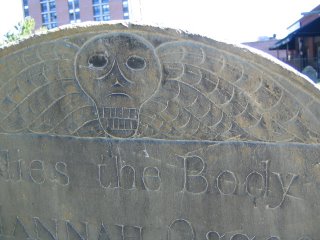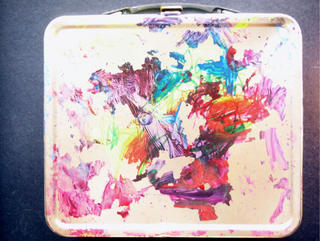from Salem, Mass.













The whole show was devoted to James Frey and A Million Little Pieces. His mom and dad and brother were in the audience. Oprah showed several video clips. In the first one, and Oprah camera crew took James back to the small town in Michigan where his trouble with drinking and drugs really began. It was the first time he'd been back since they lived there, and just being there brought back a lot of bad memories and feelings. He pointed out the street where he would buy drugs to sell to other kids. The next clip showed a woman who credits James and A Million Little Pieces for saving her life and getting her into rehab for her addictions. The entire Oprah studio audience was made up of people who had written in to Oprah about the book, so there were a lot of people there who had been through similar experiences themselves, or had a family member struggling with addiction. James in person is a lot like I imagined he would be from reading his writing: frank, honest, and incredibly tough. When Oprah called on the audience to ask questions, several people asked very probing personal questions about material in the book, such as "Did you ever speak to your college girlfriend again?" and "Where would you be now if Lily hadn't died?" and James admitted that talking about painful events like those is still very difficult for him.
One of my favorite moments of the show was when Oprah brought up the agonizing scene in the book when James gets two root canals without any pain medication or anesthesia. James' response was something like, "Physical pain is just physical pain. I can deal with that. Emotional pain is so much worse. I would much rather get my teeth fixed again than get my heart broken again."
Another great moment came when Oprah asked about the non-standard punctuation and style of the book. James responded that when he decided to be a writer he wanted to be a really great writer, so he went and looked at Morrison and Faulkner and people who had written truly great books, and the one thing they had in common was that when their books came out nobody had seen anything like it before. So he decided to strive to do something really new and different that hadn't been done before, which was to tell a true story about addiction and rehab and do it in a completely honest way, and in a conversational style. He also mentioned that A Million Little Pieces was a nightmare for proofreaders because of the non-standard punctuation, line-breaks, and capitalization.
There was lots more, but I don't want to give everything away! I was actually in the Oprah show audience the day she announced the book club selection as well. James' mom had been planted in the audience as a surprise, and her reaction when she heard Oprah say the name of her son' book was priceless. It was neat to see her again, this time all made-over with a great new haircut and stylish outfit. Someone in the audience even asked to give her a hug before the show started, and both parents got a standing ovation.
James Frey is married and he has a baby girl. The video clip of James and his wife playing with their baby at the park was very touching. The whole show was very touching, really. Oprah always makes me cry, but if you've read A Million Little Pieces or have been personally affected by alcoholism or drug addiction, definitely plan to have some tissues ready when this show airs.
By Dayana Yochim (TMF School)10/13/2005
Forget everything you thought you knew about America's debt problems. It's not reckless spenders racking up a record $800 billion in balances on credit cards that's the problem. The problem is with average Americans just trying to make ends meet, according to a new study.
In the past six years, credit card debt has nearly tripled. And last year, 1.8 million people declared bankruptcy, up from 616,000 in 1989. What are those who owe putting on plastic? It's not designer duds and criminally priced movie theater popcorn. It's basic living expenses.
"The Plastic Safety Net," released Oct. 12 by policy research and advocacy groups Demos, the Center for Responsible Lending, and the AARP, reveals what's on our credit cards, why it's there, and what we're doing to manage our financial obligations.
More than 1,000 households were surveyed. (To participate, they had to have credit card debt for three months or longer and household income between 50% and 120% of the local median income, establishing them as low- and middle-income households.) Their answers provide context for the growing void between the haves and have-nots and reveal the fallout from more than a decade of irresponsible lending practices, increasingly predatory fees, and growing economic instability.
What's on your credit card?
The study found that most debt-strapped households use credit to cover unavoidable expenditures, not discretionary purchases. We're increasingly relying on plastic loans to pay our rents, mortgages, utilities, groceries, car repairs, and insurance premiums.Seven out of 10 low- and middle-income households surveyed reported using credit as a survival safety net. One household out of three said it was forced to put these charges on a card for four out of the past 12 months because the household didn't have the cash available to cover the bills.
The average amount of debt carried by survey respondents was $8,650; 29% were strapped with more than 10 grand on credit cards, while 24% carried between $2,500 and $5,000, and 31% owed less than $2,500.
Unfortunately, debt tends to linger. The average amount of time of debt was about three and a half years, according to the survey. Lenders certainly aren't rushing consumers to pay down their balances, despite the recent increase in minimum payment requirements. Last year, banks made $80 billion in interest charges, and the industry raked in an all-time high of $31 billion in fee income, which includes annual fees, cash-advance fees, balance transfer fees, and merchant fees.
Why can't you pay it off?
Layoffs, major medical expenses, education costs, and bad transmissions are evidently the things that separate the economically vulnerable from the fiscally stalwart. When asked to cite what contributed to their current level of debt, respondents cited the following:
- Car repairs (48%)
- Home repairs (38%)
- Major appliance purchase (34%)
- Basic living expenses (33%)
- Illness or necessary medical expense (29%)
- Layoff or loss of a job (25%)
- Tuition or expenses for a child, spouse, partner, or self (21%)
- Money given to family members or used to pay debts of other family members (19%)
- Tuition or other expenses for a child who's high school age or younger (12%)
- None of the above (12%)
- One or more of the above (88%)
Misinformation about establishing credit was also cited. Thirteen percent of consumers said they were carrying debt to improve their credit score. But it's not how much debt you carry that boosts your score, nor is it that you keep a balance on your credit card. It's how you handle the credit extended to you. Time (the longer the better) and the responsible use of credit (paying your bills on time and keeping your debt-to-available-credit ratio well below 25%) are the best ways to build a solid credit history.
What are we doing to pay it off?
Despite stereotypes of deadbeat debtors, just 11% of survey respondents said they would continue to use their credit cards as they had in the past. Nearly half said they had immediate plans to keep their cards in their wallets so they could pay off the debt, and 33% said they would like to do the same but that they would have to use credit as needed.In fact, nine out of 10 customers try to pay more than the minimum required payment each month (the average amount paid among all respondents was $700) -- and 41% of those paying more said they planned to pay two to three times what lenders required to get rid of their balances quicker.
Slackers, these customers aren't: Two-thirds of households said they were budgeting to control expenses. More than half had cut back discretionary spending in the past six months.
But good intentions aren't enough, particularly when lenders are watching every move their customers make. Increasing penalty rates -- and the growing reasons for instituting them -- are certainly keeping debt-strapped households in the cycle.
This year, credit card companies will rake in $16 billion in penalty fees -- what Mark Peace, the president of the Center for Responsible Lending, calls the penalty-pricing trap. Not only are late fees at an all-time high (less than half of consumers said they had missed or were late with a payment in the past year), but lenders also now hike interest rates after a single late payment -- even if it's a bill from another lending institution altogether.
More than 40% of lenders now use the universal default clause. Via routine credit report checks, they see whether you have been behind in any of your bills, thus marking you as a higher credit risk. Lenient lender-consumer card agreements stipulate that they can increase a customer's interest rate two- or three-fold if they want. (The average default rate is 25%. Companies cited as "steep chargers" include Providian(NYSE: PVN), Bank of America(NYSE: BAC), and MBNA(NYSE: KRB).)
A 25% penalty rate translates into more than $1,100 in additional interest costs each year for a household with the average debt load of $8,650 originally at 12% interest. "Dear valued customer, thanks for the $16 billion bonus!"
The ultimate bottom line
Covering their assets is certainly within lenders' rights. But responsible lending practices seem to have taken a back seat to bottom-line results.Credit card companies aren't just encouraging card-shuffling -- hopping from one lender to another -- when they send out 5 billion solicitations annually. They're cheering on consumers to take on more credit than they can handle. "Treat yourself right this month," they tell us with "convenience checks" loaded with fees. "Oh, and if you slip up and we find out about it -- and trust, us, we're looking -- forget that sweet low-rate deal we just mentioned. Everything you've charged up to now and from here on out will be subject to a meaty interest rate."
When the bankruptcy bill goes into effect on Oct. 17, lenders get yet another hand to play in their favor. The Plastic Safety Net study shows that even the best-intentioned debt-strapped households -- and most of them are diligent about their finances -- are living in a house of cards.
For more, check out:
- Sneaky Credit Card Tricks
- Who Has the Keys to Your Credit File?
- All Eyes Are on Your APR
- The Fool's Credit Center
- Post of the Day: The Middle Class Squeeze
- When to Turn Down "Help"
- Center for Responsible Lending
Dayana Yochim owns none of the companies mentioned in this article. The Motley Fool's disclosure policy is cemented in stone.
